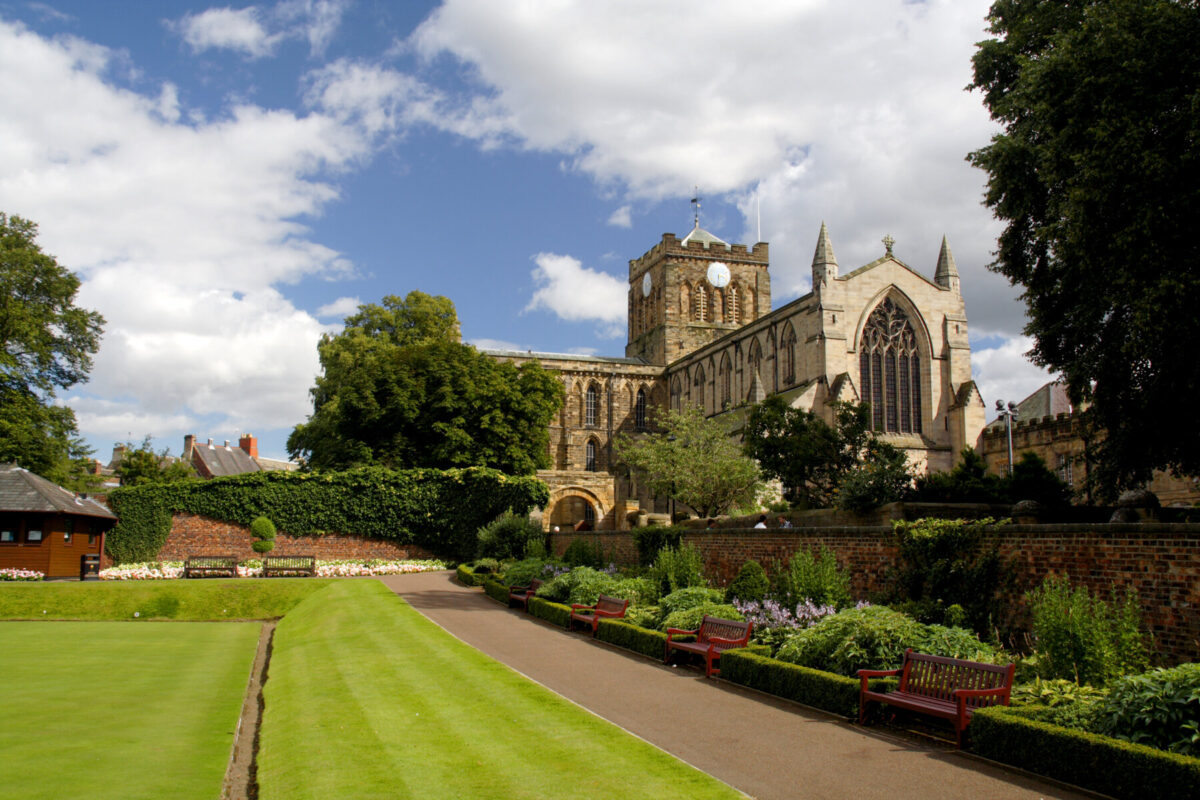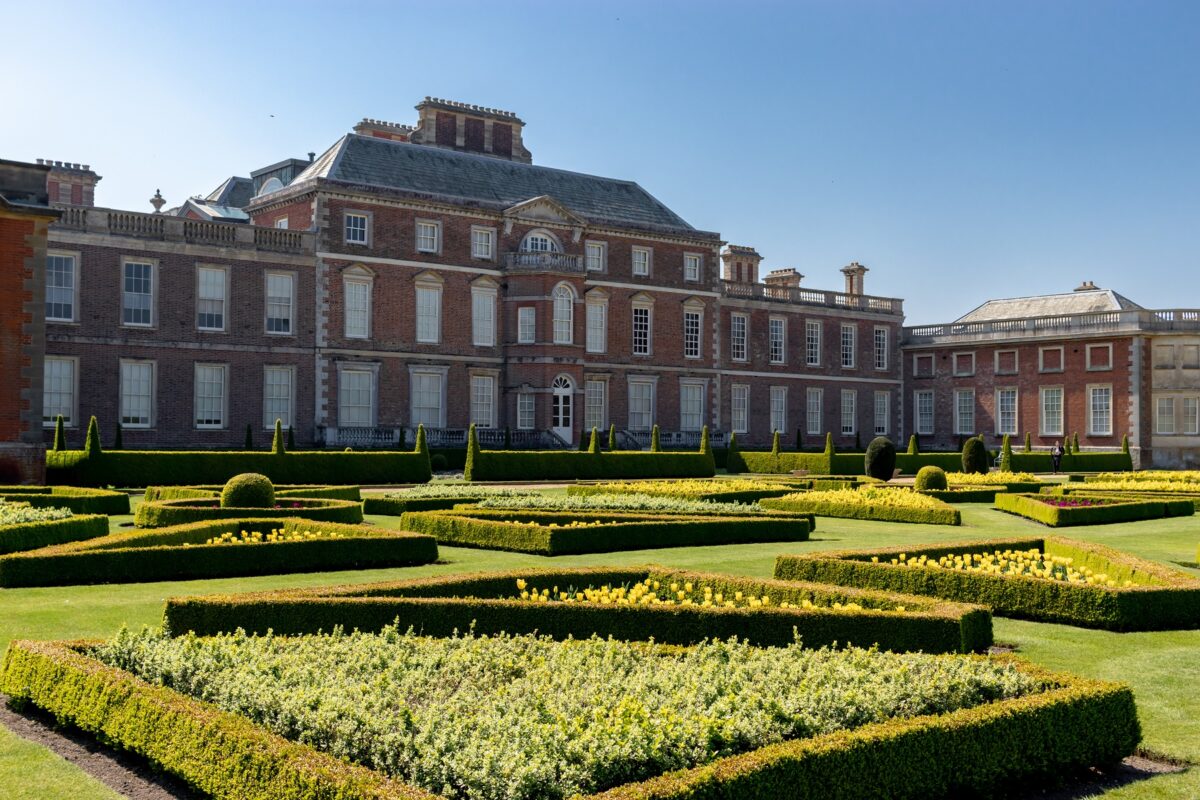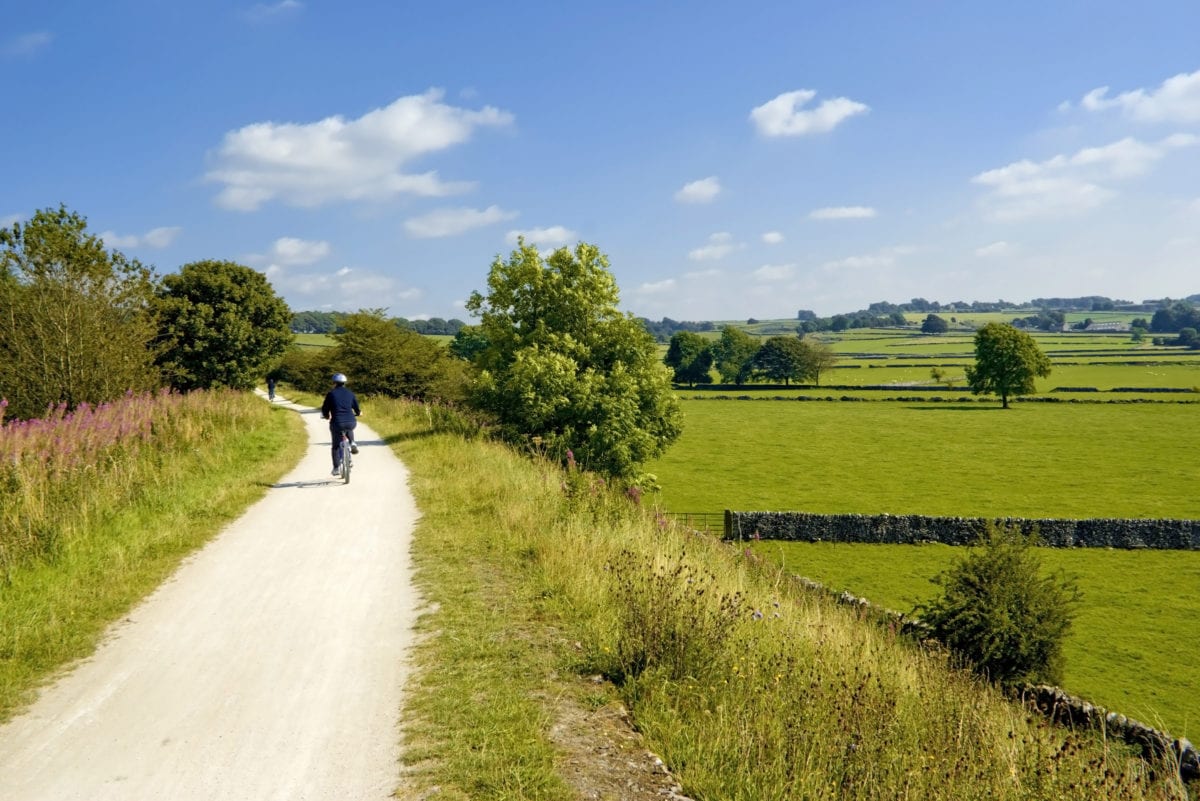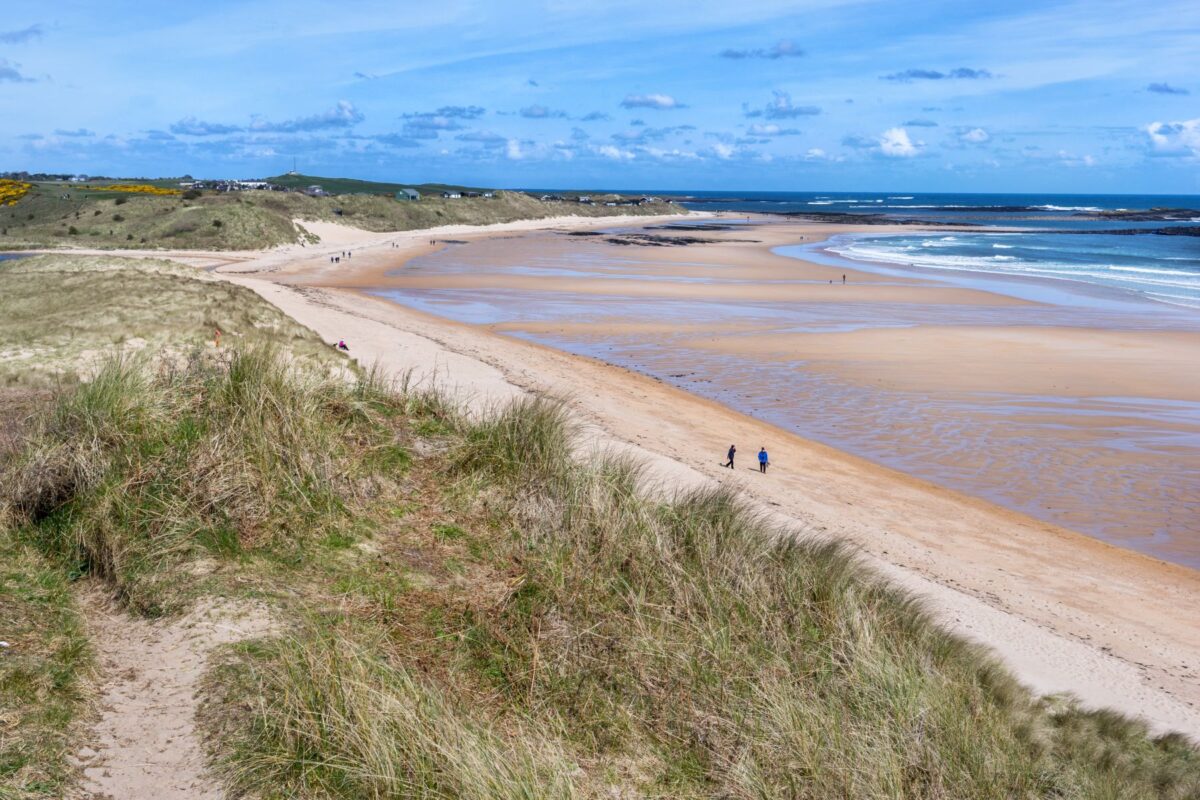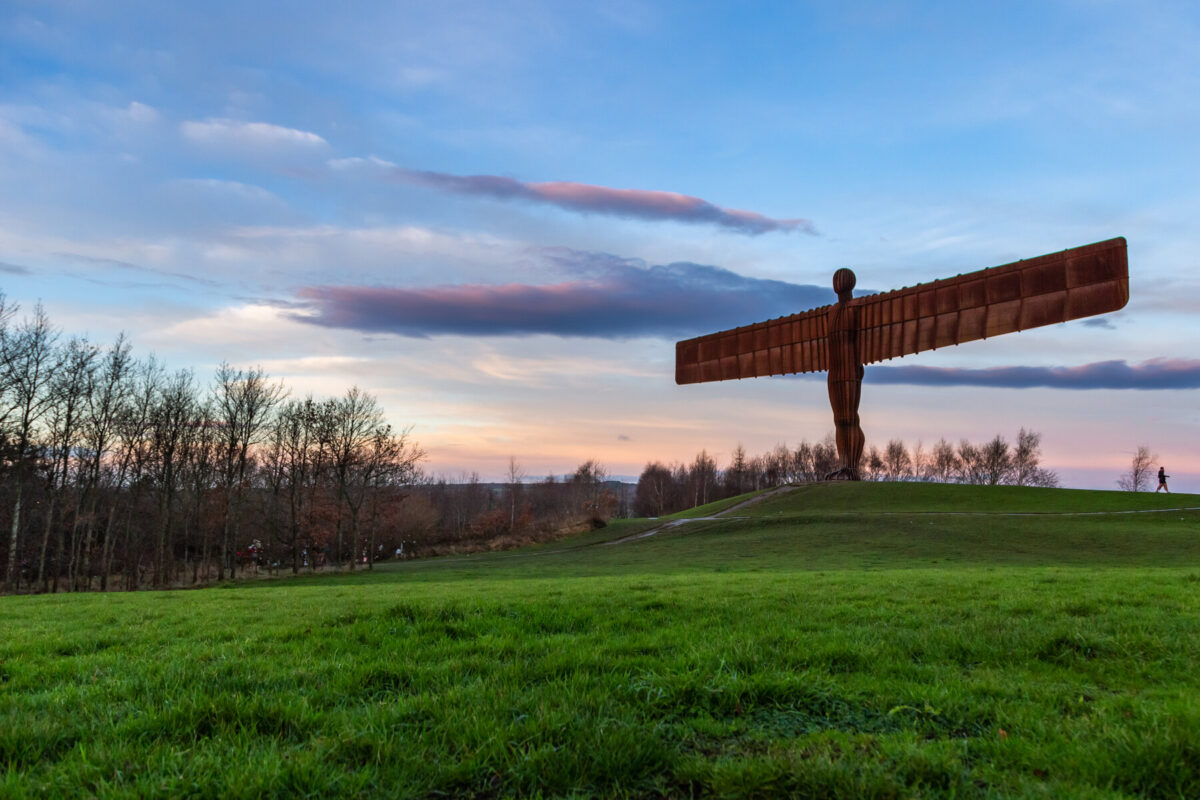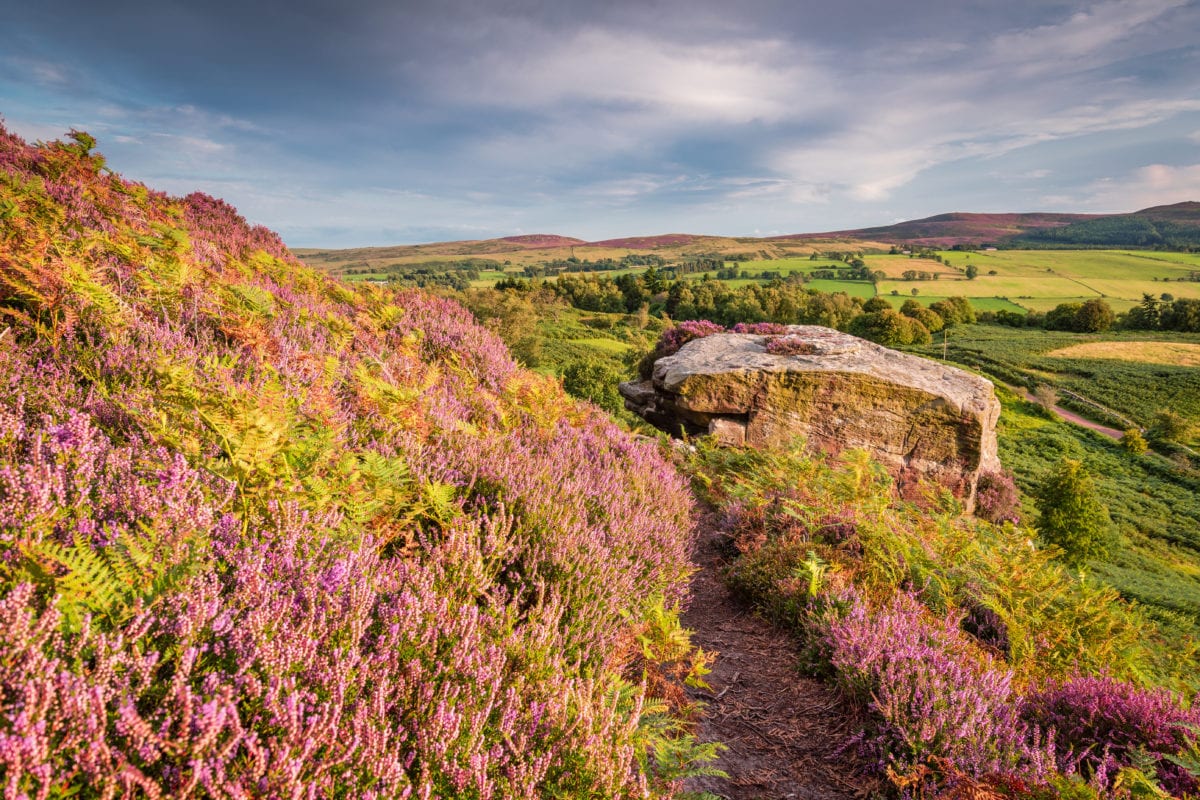Take a hike through the Cheviot Hills, sample the fresh seafood at Craster, or catch the surf in Tynemouth Bay; whatever you choose, you’re never far from the region’s eclectic mixture of warm hospitality and solitude.
Gemma Hall, author of Slow Travel Northumberland
Lovers of Slow travel need look no further than Northumberland, a region that you can savour at your own pace. Whether it’s a short break or a fully fledged holiday in England’s northeast, opportunity abounds for lovers of castles, moorland, industrial history, Roman architecture and sandy beaches – and that’s just the beginning.
Many arrive in Northumberland hoping to explore picturesque stretches of Hadrian’s Wall or the religious history of Lindisfarne, but end up staying for the other things they find: vast swathes of raw upland and coastal scenery beneath some of the most star-filled skies in all of the UK. Take a hike through the Cheviot Hills, sample the fresh seafood at Craster, or catch the surf in Tynemouth Bay; whatever you choose, you’re never far from the region’s eclectic mixture of warm hospitality and solitude.
And if you’re a city-slicker looking for something livelier than pristine woodland and gorgeous coastline, Newcastle and Gateshead offer a cultural scene that has been thriving under the watchful gaze of The Angel of the North since the 1990s, now sitting comfortably among the best in Europe.
Sample the buzzing nightlife, art galleries and theatres, or just meander between the Georgian architecture as you listen to the cries from St James’s Park on match day – just be sure you’re wearing black and white!
Bradt on Britain – our Slow Travel approach
This series evolved, slowly, from a Bradt editorial meeting when we started to explore ideas for guides to our favourite country – Great Britain. We wanted to get away from the usual ‘top sights’ formula and encourage our authors to bring out the nuances and local differences that make up a sense of place – such things as food, building styles, nature, geology, or local people and what makes them tick. Our aim was to create a series that celebrates the present, focusing on sustainable tourism, rather than taking a nostalgic wallow in the past.
So without our realising it at the time, we had defined ‘Slow Travel’, or at least our concept of it. For the beauty of the Slow movement is that there is no fixed definition; we adapt the philosophy to fit our individual needs and aspirations. Thus Carl Honoré, author of In Praise of Slow, writes: ‘The Slow Movement is a cultural revolution against the notion that faster is always better. It’s not about doing everything at a snail’s pace, it’s about seeking to do everything at the right speed. Savouring the hours and minutes rather than just counting them. Doing everything as well as possible, instead of as fast as possible. It’s about quality over quantity in everything from work to food to parenting.’ And travel.
So take time to explore. Don’t rush it, get to know an area – and the people who live there – and you’ll be as delighted as the authors by what you find.
For more information, check out our guide to Northumberland
Food and drink in Northumberland
Visitors to the region will be struck by how many restaurants, pubs and food stores have got behind the organic and local food revival. Many menus in good restaurants and cafés state the provenance of ingredients as standard practice; pubs serving regional ales are now too numerous to list; and I found plenty of B&B and hotel owners taking pride in serving local foods (look out for the Produced in Northumberland accreditation when booking accommodation).
Northumberland boasts many of the best salmon and trout rivers in England, extensive game moors and working fishing communities, so it makes sense. Famous names you will undoubtedly come across on your travels include Craster Kippers, Lindisfarne Oysters, Pumphrey’s and Pilgrim’s coffees, Chain Bridge Honey, Doddington Dairy, the Northumberland Cheese Company, and Allendale and Wylam breweries.
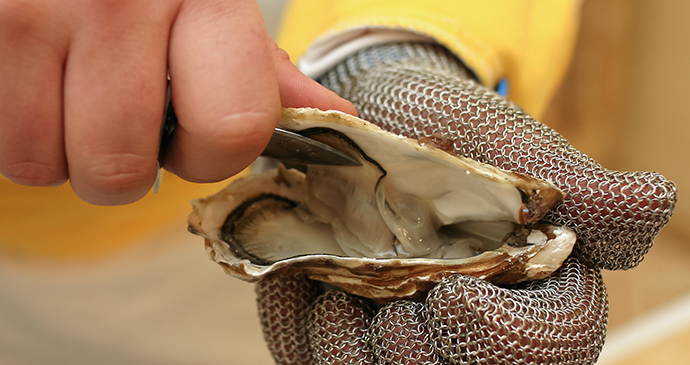
For those self-catering, you’ll find thriving farmers’ markets in most large towns, excellent fishmongers and/or smokeries at North Shields Fish Quay, Craster and Seahouses, and farm shops like Blagdon near Ponteland. Recommended delis include the Corbridge Larder, the Good Life Shop in Wooler, and Tully’s of Rothbury.
Dishes unique to the North East include pan haggerty (a filling potato and onion side dish) and singin’ hinny (a very filling kind of scone that ‘sings’ as it hits the bubbling butter on a griddle pan). Also look out for sandwiches made with stottie bread (flat, spongy and slightly sweet) that are fairly easy to find in take-away shops and cafés.
Local specialities
Lindisfarne oysters
Oysters have been harvested for hundreds of years on the mudflats of Lindisfarne bay. Past owners of the oyster beds include monks in the 14th century and a Victorian landowner. The industry died out but was resurrected in 1989 by a local farmer who spotted oyster shells on the sand.
Current owners, Christopher and Helen Sutherland, inherited the business in the early noughties. You can buy their oysters at Swallow Fish smokehouse in Seahouses, online, or direct from Ross Farm if ordered in advance.
Chain Bridge Honey
Chain Bridge honey is ubiquitous in Northumberland, and no doubt you will have already come across their pots of liquid gold in farm shops, B&Bs and delis across the North East.
You can buy (and try) all their different honeys and various beauty products from the friendly visitor centre on the sprawling farm. The Flower Comb Honey has a particularly strong taste and scent (I’ve never found a flower honey as good as this anywhere in England). In the shop you’ll see a working hive with an observation glass panel next door and an exhibition room tells you everything you want to know about bees and bee-keeping.
Where to stay in Northumberland
For information about accommodation, see our list of the best places to stay in Northumberland.
What to see and do in Northumberland
Alnwick
‘Alnwick is ever under the spell of the dreamy past’, a late 19th-century visitor to the town observed. Today, you might also say it is under the spell of Harry Potter, whose fans flock to the town’s famous medieval castle, better known to some as Hogwarts.
For others, even without its fortress and celebrated gardens, Alnwick (pronounced ‘Annick’) is one of the most vibrant and historically interesting market towns in Northumberland, and easily reached from the coast by car in 20 minutes.
What to see and do
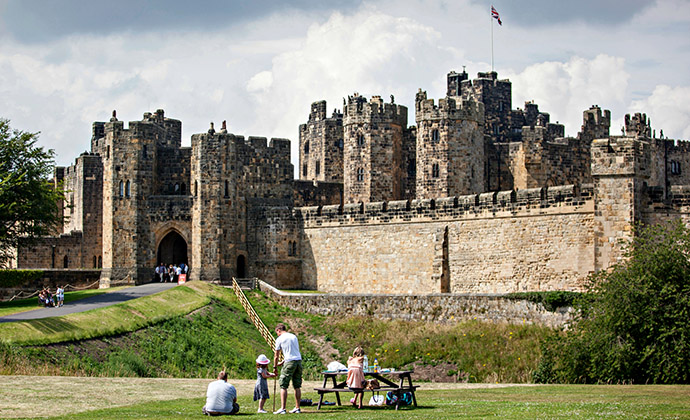
Alnwick Castle
Alnwick Castle is often referred to as the ‘Windsor Castle of the North’ in tourism literature on account of its size and imposing buildings. Like Windsor, it’s home to royalty; well, Geordie royalty at least. The Duke and Duchess of Northumberland are historically one of the most powerful aristocratic families in England; they own huge amounts of land and property, including this almighty fortress.
Ever since the filming of Harry Potter in 2000, the fortress has become known to many young visitors as Hogwarts School of Witchcraft and Wizardry. The managers are only too happy to indulge them and you’ll find broomstick-riding lessons (as entertaining for spectators) among the array of wizard- and medieval-themed activities.
Alnwick Castle is clearly a huge hit with families, but there’s also much to interest those with a love of porcelain, fine art (the castle houses a distinguished collection of Renaissance art, including eight paintings by Canaletto and three Titians) and, of course, gardens.
The Alnwick Garden
The gardens at Alnwick are unashamedly bold and contemporary and designed to thrill. You can easily spend a whole afternoon – or day – here and you’ll find children are entertained as much as garden lovers are absorbed by the plant collections.
The centrepiece is the Grand Cascade, a huge modern waterfall lined with fountains that plunges over many tiers. Below, children drive toy dumper trucks under the spray of water (parents in the know come prepared with swimsuits). If children do manage to escape getting wet here, they probably won’t at the nearby Serpent Garden, where a series of interactive contemporary installations use water to creative effect.
St Michael’s Church
‘Don’t tell me the Victorians were good engineers,’ said the warden pointing to a bowed wall that began to tilt in the years following a 19th-century reconfiguration of the medieval church. Despite this, St Michael’s certainly gives the appearance of strength and steadfastness with its short, castellated tower supported by wide buttresses, and retains much of its earlier structure built under King Henry VI in 1464. The unusual turret on the southeastern corner of the church served as a lookout point during the centuries of Border fighting.
Step inside and you’ll find many more curious features including, in the baptistery, a medieval statue depicting King Henry VI and a serene looking martyr whose body is pierced with many arrows. At the far end of the north aisle is a stone carving above one of the pillar capitals of an angel holding a Catherine wheel (to the right of St Catherine’s Chapel).
Hulne Park
Not far from St Michael’s Church is the imposing gateway to Hulne Park – a huge area of woods and open parkland (formally a hunting ground) enclosed by walls and owned by the Duke of Northumberland. Several miles of footpaths and paved tracks open to the public wind through the trees, over stone bridges, past dells and across open grasslands.
Shopping
A farmers’ market fills Alnwick Market Place on Fridays from April to October where you’ll find plenty of Northumbrian produce on sale. Saturday’s market is a mixture of crafts, plants, local artwork and clothing stalls with the odd local produce table.
At Alnwick Station, Barter Books oozes old-world charm with its decorative ironwork, working station clocks, wonderful waiting room café, open fires and model trains that trundle along on a track above the rickety bookcases. Between two bookshelves is a stone water basin (still with its brass cups attached to chains) once used by railway passengers.
Bamburgh
One of the most bewitching coastal views in Northumberland bursts upon the traveller on reaching the brow of the B1340 between Waren Mill and Bamburgh. From here, Bamburgh’s famous medieval castle comes into sight, spectacularly rising from the dunes – all rock, turrets and battlements.
It is undoubtedly one of England’s finest coastal fortresses and this is one of the most unspoilt and dramatic coastal panoramas, with the Farne Islands to the south, Lindisfarne Castle silhouetted on its rocky perch to the north, and the wide, creamy sands of Bamburgh’s three-mile beach below. The view is most expansive from the castle’s Battery Terrace.
What to see and do in Bamburgh
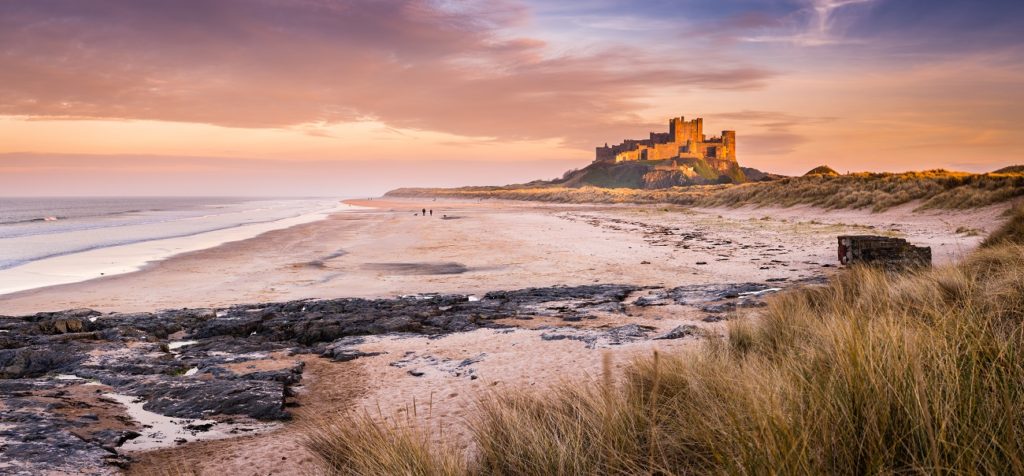
Bamburgh Castle
Many writers and architectural historians have declared Bamburgh the most wondrous of all England’s coastal castles. You may well agree when you see its stonking curtain walls and keep crowning a fist of dolerite rock thrust 150 feet from sea level through dunes. Bamburgh is certainly the stuff of fairytales.
Its enviable situation proved a valuable vantage point for settlers from ancient times and almost certainly the Romans. From the Anglo- Saxon period to the present day, Vikings, kings, earls and dukes have seized, pounded and abandoned the castle in various states of ruin. Some of Bamburgh’s Anglo-Saxon treasures are displayed inside the Archaeology Room, and include part of a stone throne.
Bamburgh village
My 19th-century travel guide describes Bamburgh as ‘clean and cheerful’ and a ‘model village’. Nothing has changed in that respect. The centre is almost entirely made of stone and centred about a wooded green. Front Street has a pleasing run of 18th-century stone cottages, a number of which are now gift shops, eateries and B&Bs.
Keep heading uphill and you’ll reach Bamburgh Gallery, the sister studio to the Chatton Gallery near Wooler. Most prints and original pastel landscapes (largely depicting the coastal scenery between Bamburgh and Lindisfarne) are by well-regarded artist, Robert Turnbull, and prices are reasonable.
Those wanting to escape the throb of tourists in the village centre may like to walk (or cycle) along The Wynding – a quiet paved lane (opposite the Lord Crewe Hotel) north out of the village to a golf course. Walkers can continue beyond the green to Budle Point and drop down on to the sandy shore. A beach towel comes in handy here.
Instead of retracing your steps to Bamburgh, you can make a circular loop via the bird-rich flats of Budle Bay. From Budle Point, continue west on the coast path before striking off inland to meet the B1342 for the final mile back to Bamburgh (on a grass verge).
Grace Darling Museum
Facing the sea to the northwest of the village is this enchanting museum that perpetuates the memory of the Victorian heroine who helped save shipwrecked passengers off the Farne Islands one stormy night in 1838.
The collection of memorabilia in the small museum – including the lifesaving coble rowing boat and some of Grace’s clothes – is elegantly presented. You’ll learn about events on that fateful night, the life of the lighthouse keeper and his family and Grace’s rise to fame in the years following the rescue – an intriguing tale in itself.
On the top floor, children can dress up as RNLI crew and mess about in a model boat. As you walk up the stairs, note the atmospheric Carmichael oil depicting Grace and her father rowing across heaving waves to the sinking ship.

Farne Islands National Nature Reserve
‘A boat may be secured for fifteen shillings. In addition to this charge, the boatmen expect to be provided with refreshments, solid and liquid.’ Visitors to the Farne Islands no longer need to supply the skippers of the Seahouses’ tour boats with food and drink, as they did in the late 19th century, but little else has changed here since Victorian tourists came to experience the famous bird islands.
Everyone who has visited these rocky isles scattered a couple of miles northeast of Seahouses will remember ducking and flinching from the dive-bombing arctic terns. A wave of the hands usually keeps the birds, which are ever so protective of their chicks running at your feet, from striking, but you might want to wear a hat just in case.
From the moment you step ashore, you’ll see puffins crash-landing with beaks stuffed full of sand eels, terns wheeling in the sky or spearing fish from the sea, cormorants sitting proud on their castles of dried seaweed, and guillemots guarding rock stacks painted white with guano. There is no other wildlife experience quite like this anywhere else in Northumberland. But only for a few months of the year. Come mid-August, the birds depart for open waters, abandoning their empty nests to the wind and sea.
The islands
The islands are divided into two main groups by Staple Sound. On Inner Farne, boardwalks guide visitors on a half-mile long round-island walk. Tens of thousands of puffins nest here in burrows they dig themselves (not old rabbit burrows as is sometimes thought), while razorbills, kittiwakes and guillemots lay their eggs on the columnar seafacing rocks (part of the Great Whin Sill that peaks in several places along the Northumberland coast). Sea campion covers much of the ground that isn’t bare rock.
Inner Farne was inhabited by hermits and monks for 900 years; the most well known was Cuthbert, who lived twice on the island before and after he became Bishop of Lindisfarne. The second time, in AD687, he returned to his much-loved sanctuary to die.
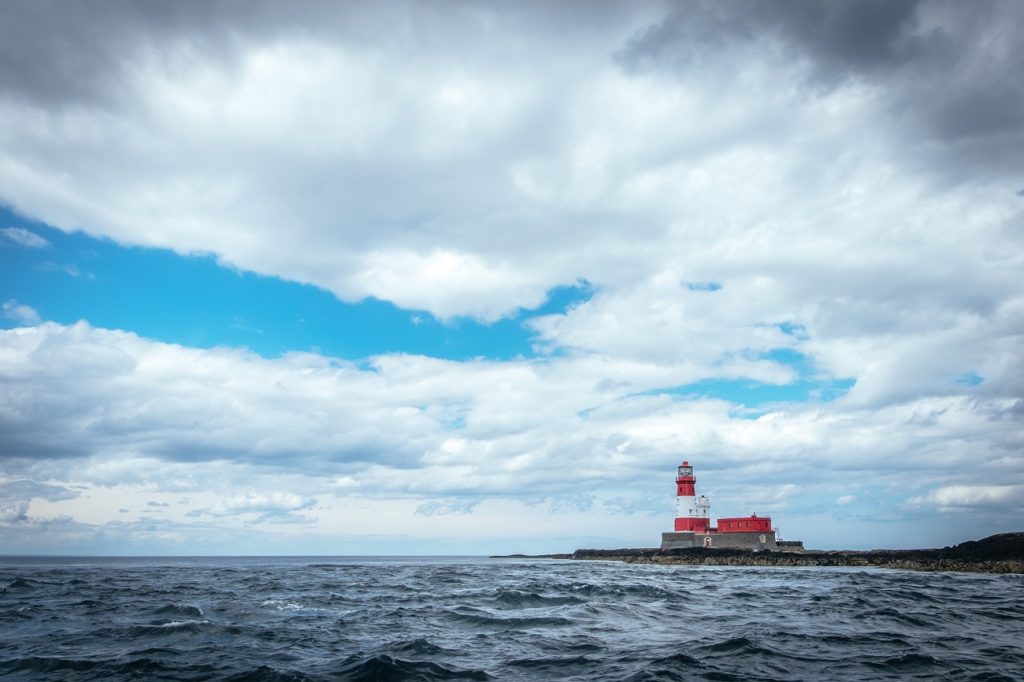
Nothing remains of Cuthbert’s simple shelter and prayer room, but you will see a few old stone buildings, including a chapel built around 1300. The 17th-century wood stalls inside came from Durham Cathedral.
Two lighthouses still operate on the Farnes, both dating to the early 1800s. The red and white beacon on Longstone is the famous ‘Grace Darling lighthouse’ from where the lighthouse keeper and his daughter rowed through a storm in 1838 to aid survivors of a shipwreck. In the years following the rescue, Victorian tourists would visit the famous family at the lighthouse and delight in hearing of the extraordinary event first hand. Today, you’ll need to visit the Grace Darling Museum in Bamburgh.
Boat trips
Boat tripsdepart hourly between 10.00 and 15.00 depending on the weather and can be booked from the kiosks at Seahouses harbour. Tours of the islands offer close-up views of seals and cliff-nesting birds before landing on Inner Farne.
Note that most seabirds will have left the islands before the end of the summer but eider ducks, cormorants, shags and seals can be seen throughout the year, and there are winter migrants from early autumn. Allow for a round trip (including the Inner Farne stop-off) of three hours. Birdwatchers and photographers may want to combine a trip to Inner Farne with Staple Island.
Hadrian’s Wall
When built 2,000 years ago Hadrian’s Wall stood ten feet high; today half its height remains in places. Spanning 73 miles from coast to coast across the neck of England, it is the region’s most celebrated attraction – and an awe-inspiring feature of the rugged Northumberland landscape.
According to English Heritage it is ‘the most important monument built by the Romans in Britain’. The best-preserved stretch, between Chesters and Brampton, rides the tops of the highest hills and rocky ridges where undulating grasslands roll far into Cumbria and down through the Tyne Valley. This is superb walking country indeed.
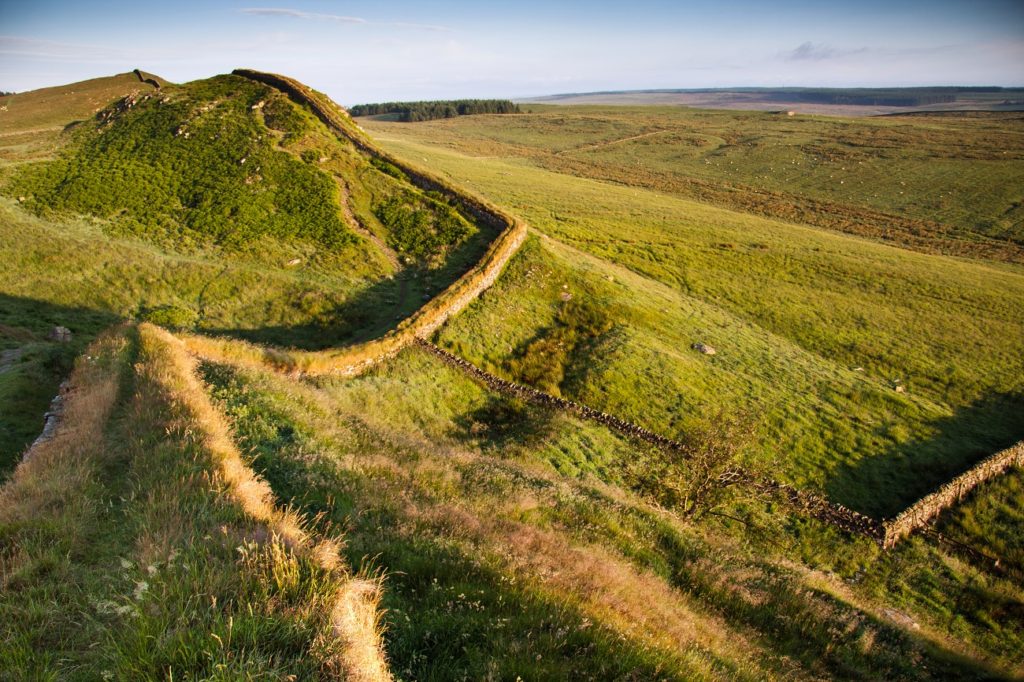
What to see and do along Hadrian’s Wall
Walking routes
Ramblers will find no shortage of excellent walks in and around Hadrian’s Wall. The scenery doesn’t really get going until your back is to Heddon-on-the-Wall, but from then on the landscape becomes increasingly remote, rough, ascending and unbound.
By the time you clear Chollerford and Chesters Roman Fort on heading west, you enter the most memorable countryside on the whole of the Wall: undulating farmland, large glacial lakes, soaring craggy cliffs and far-reaching views north across Redesdale’s forests.
Cycle trails
Hadrian’s Cycleway is well signposted (National Cycle Network route 72) on its 174-mile course from Ravenglass on the Cumbrian coast to South Shields on the River Tyne. In Northumberland, it mostly runs south of Hadrian’s Wall; the off-road stretch along the Tyne through Newcastle to the North Sea is shared with the Hadrian’s Wall Path for walkers.
Cyclists can make good use of the Newcastle–Carlisle railway to access Hadrian’s Wall, which is never more than a few miles north of stations on the line. Bikes travel free; two per service; no need to book in advance.
The forts
Housesteads
Housesteads is the most complete Roman fort in Britain and the most visited of the four main garrison stations in Northumberland, owing in part to its dramatic position commanding the lip of an igneous cliff. Built in the years following the construction of Hadrian’s Wall, the fort sits snug to the stone barricade, teetering on the edge of the Roman Empire.
As with other forts, Housesteads is typical in its arrangement of buildings with its centrally located headquarters, granaries, hospital and commanding officer’s residence. The last consists of rooms arranged around a courtyard and has an excellent example of Roman under-floor heating technology. The floor, now mostly removed, was raised on rows of pillars under which hot air circulated.
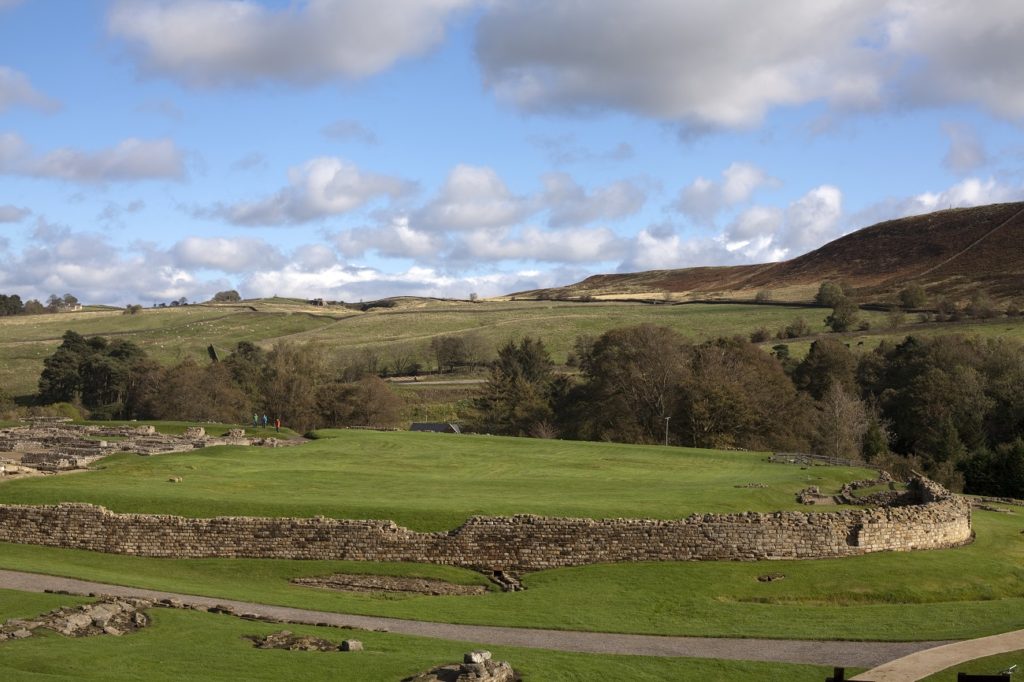
Vindolanda
A mile upstream from Bardon Mill and the same distance south of the Wall is this Roman military station and museum housing some of the most important Roman finds ever recovered.
Discoveries are still being made today by experts and volunteers involved in Vindolanda’s active archaeological research programme that began in the 1970s. Recent finds include two leather boxing gloves, a new hoard of writing tablets, and a gold coin dating to AD64–65 that bears the image of the Emperor Nero. Its value to a Roman soldier was over half a year’s salary (pity the soldier who dropped the coin in the ground).
Chesters
If Housesteads is ‘the fort with the loos’ and Vindolanda the one with the high street and writing tablets, then Chesters is all about the bathhouse.
At least that’s what it has become known for. Chesters also boasts a museum that has been open to visitors since 1896 and is filled with an astonishing collection of Roman treasures amassed by John Clayton between 1840 and 1890. It is thanks to him that so many Roman artefacts and buildings in Northumberland survive at all.
Birdoswald
Compared with Housesteads and Vindolanda, the fort at Birdoswald is more ruinous and has fewer buildings, but its curtain wall, granaries and well-preserved fort gate are worthy of note – and, wow, what a view!
Situated at the top of a steep, wooded escarpment, the military station and Victorian farmhouse look across several miles of undulating fields and Roman Wall. The two granaries date to the early 3rd century, but were demolished and rebuilt in the following century. The posts you see mark where a later Dark Age timber hall once stood.
Kielder Water and Forest
England’s largest forest, covering 230 square miles of remote, upland terrain, is one of the most isolated corners of England with the clearest night skies; yet it doesn’t feel like England at all. As you motor into Kielder along the lakeside road, the tall Sitka spruce trees close in on you, and for a while the landscape takes on the appearance of the great Highland forests. The scenery is made all the more Scottish in character by vast areas of open moorland, ospreys and red squirrels.
Kielder is no untouched wilderness, however, this being a plantation forest surrounding the largest reservoir in northern Europe and supplying 25% of England’s domestic timber. It may be a young landscape, created in the aftermath of World War I to replenish timber supplies, but it is still astonishingly scenic. The Campaign to Protect Rural England described Kielder as the most tranquil place in the country with the darkest night skies. If you’d like to be convinced of this, I recommend a dusk walk to the Observatory.
Activities in Kielder Forest
Cycling
Off-road cycling and mountain bike trails range from family-friendly green routes such as the Borderline Trail from Kielder village along an old railway line, to red routes like the Deadwater Trail (and its black route extension) that climbs to the summit of Deadwater at 1,900 feet. At the top you can see the Pentland Hills, just south of Edinburgh, and the Lake District.
Another exhilarating circular ride that actually takes you into Scotland and offers views of the Solway Firth starts out from Matthew’s Linn and follows the Bloody Bush Trail to Newcastleton; the return is via the Cross Border Trail. Hire bicycles (including electric bicycles) at The Bike Place. Download routes from visitkielder.com.
Walking
A superb network of trails for cyclists, walkers, horseriders and wheelchair users is maintained by the Forestry Commission. One of the most accessible is the Lakeside Way, which circumnavigates the reservoir in 27 miles. If you don’t want to walk (8–10 hours) or cycle (3–4 hours) the whole way round, you can return using the Osprey Ferry.
Gentle walks are plentiful around the reservoir and many routes encompass Kielder’s public art works (pick up a free Trails Guide in one of the visitor centres). The more adventurous may enjoy a hike into Kielderhead National Nature Reserve.
Wildlife watching
Ospreys, goshawks and tawny owls breed successfully at Kielder because of the remoteness of the forest and the protection from persecution afforded by the Forestry Commission. There’s an organised osprey viewing station at Kielder Waterside, but for your own private encounter you may want to continue west in the direction of Kielder Castle to Bakethin Nature Reserve and nearby viaduct where ospreys are not infrequently observed catching fish.
A large extent of Kielder is open moorland dominated by heather and sphagnum mosses and inhabited by wading birds and grouse. Dragonflies and damselflies hover over damp ground where you may also see cranberry, bog asphodel, sundew and bog rosemary.
Water voles were reintroduced to Kielder in 2016. You’ll need to be exceptionally quiet to see one – or hear the ‘plop’ of ‘Ratty’ entering a waterway. Try the wildlife hide off the Forest Drive located two miles from Kielder Castle, or in one of the burns above Kielder village.

Stargazing
No need to be an astronomy buff to go to the Kielder Observatory: the enthusiasm of the staff and volunteers at the observatory will soon have you hooked. Even without the astronomy bit, the experience of travelling to this remote place, the hilltop views at dusk and the building itself are worthy of the drive alone.
The striking timber structure juts out of the hillside on stilts; inside there are no windows, except for two roof shutters that become ‘your eye into the universe’ when they open to reveal a dark sky dusted with millions of stars. Two huge telescopes crank into gear as soon as the shutters open. They turn automatically on a room-sized circular track like sunflowers searching for the sun, except they are seeking planets, of course.
Lindisfarne Island and National Nature Reserve
Lindisfarne Castle seemingly rises out of the sea off the coast of north Northumberland, but from the causeway that connects the island to the mainland at low tide it sinks out of view and Lindisfarne as a whole appears as a long grey-green streak across a glistening expanse of sea, saltmarshes and sandflats.
It’s one of the most striking and beautiful panoramas on the Northumberland coast, so slow down and drink in the view. Beyond the grasslands and dunes on the north side of the island are some of Northumberland’s finest and whitest sandy beaches, which are often empty even in high summer.
What to see and do
Lindisfarne National Nature Reserve
When the tide retreats over Lindisfarne National Nature Reserve (the waters, mudflats and saltmarshes between the island and the mainland), it exposes a seabed that stretches for what appears to be several miles, though it is impossible to tell where the flats meet the sea when the tide is out. Even when it’s overcast, the reflected light is sharp and the sky perfectly mirrored in the silvery expanse. For ducks and waders, this is a giant bird table with enough marine creatures on offer to support tens of thousands of birds. Their numbers swell from early autumn until spring when migrant birds from the continent join in the banquet. Seals rest on exposed sandbanks here.
Lindisfarne, however, is best known as a place of Christian pilgrimage. For over 1,000 years, worshippers have travelled to the island on foot across the mud and sands – a tradition that continues today by following a line of posts that steer walkers around dangerous quicksand.
Ducks, wading birds and geese begin arriving from late summer and early autumn on the saltmarshes, grasslands and tidal mudflats surrounding Lindisfarne Island (a National Nature Reserve) where they spend the winter. Most of the time they are busy prodding the mud for food or avoiding death by peregrine. On the occasions that a raptor does swoop by (sparrowhawk and hen harrier are also possible), a pandemonium of birds takes to the sky.
There are so many vantage points, but some trusted favourites are the mainland shores of the Fenham Flats where shelduck, redshank, wigeon, bar-tailed godwit and curlew congregate in good numbers. This is a popular feeding area for light-bellied Brent geese. You can walk along the shore here though the ground is very muddy.
The reserve is also known for its grey seals and flowering plants. Dunes on the northwest side of Lindisfarne Island blossom with 11 varieties of orchids in summer. Look out for the Lindisfarne helleborine.
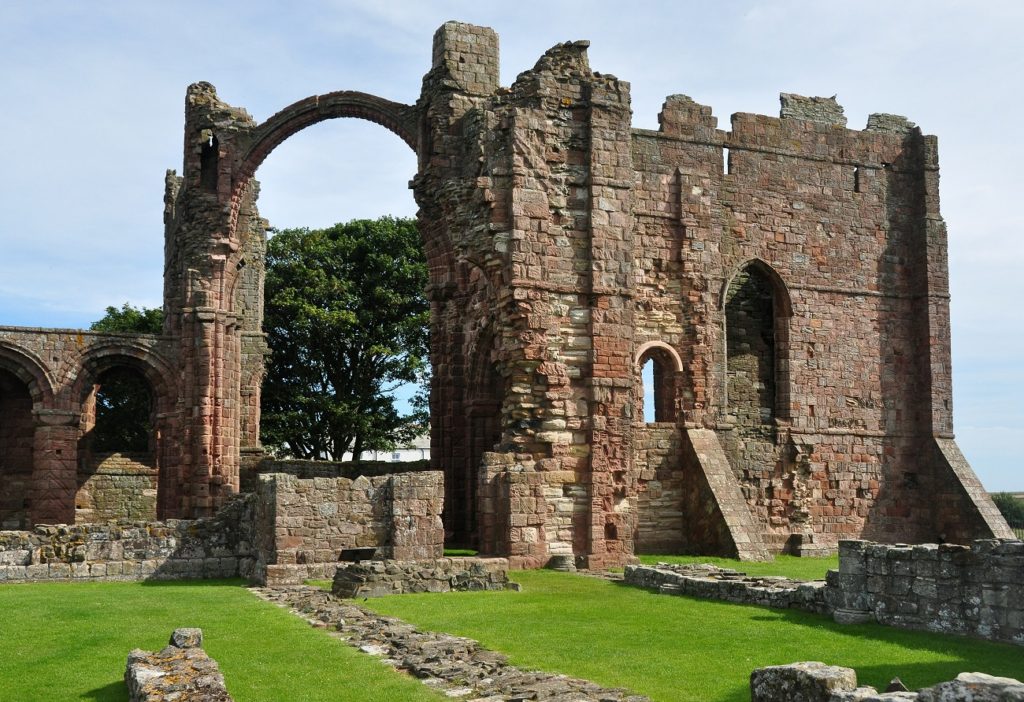
Lindisfarne Priory
The ruins of the early 12th-century priory and 13th-century parish church face each other on the southwestern tip of the island, just a few steps away from the village green. Nearly 900 years of wind and rain, as well as damage during the Reformation, have badly worn the stones of the arcades and arches of the priory, which was founded by Benedictine monks from Durham Cathedral.
Enough structures and geometric patterns remain to appreciate the layout of the building and recognise its architecture as Norman – and even to notice similarities with the nave at Durham. At dusk, the naturally blushed sandstones deepen in colour to that of a red night sky. The view from the churchyard looking over the gravestones with the priory to the left and the castle and boats in the bay to the right, is exceptionally picturesque.
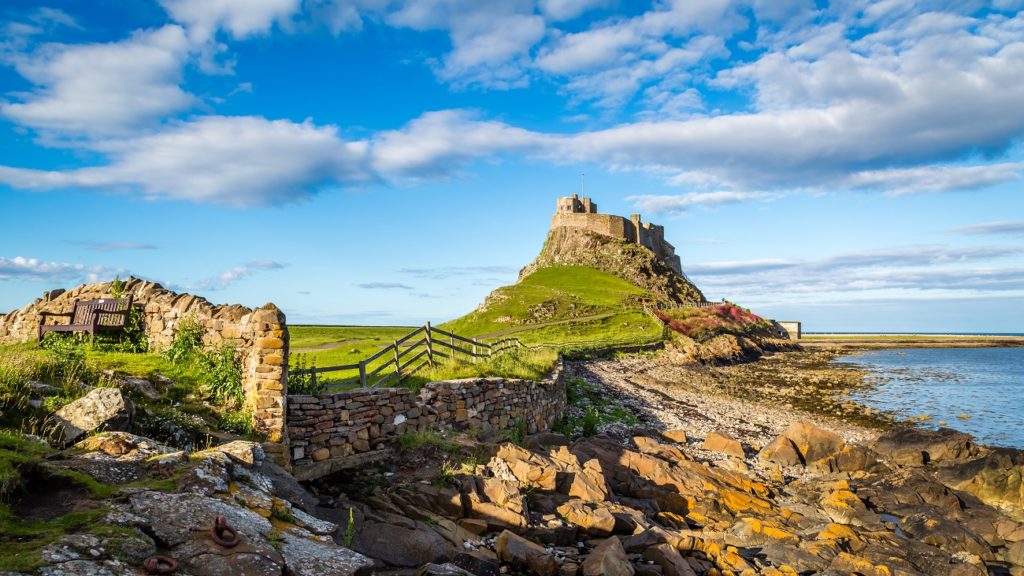
Lindisfarne Castle
Lindisfarne Castle crowns a conical-shaped mound of Whin Sill rock at the south of the island. The Tudor fortress appears to naturally emerge from the dolerite, rather than being built upon it, which is all rather pleasing from a visitor’s point of view. The castle dates from 1542 and was fortified in Elizabeth I’s reign but the strength of the impenetrable-looking walls has never been fully tested.
For many visitors, the most intriguing period in the building’s history was the evolution of the castle into an Edwardian house by architect Edwin Lutyens under the instruction of Edward Hudson, editor of Country Life magazine. He created domestic rooms in every chamber, connected by way of passages.
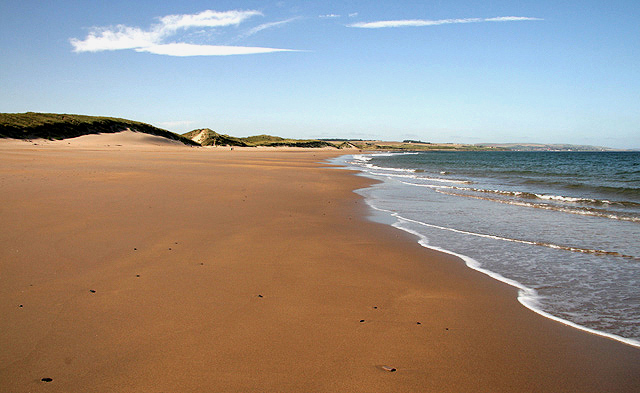
Cheswick Sands
Located far from any settlement of note means that those who do make it to this runway-straight stretch of desolate coastline between Lindisfarne and the distant outskirts of Berwick find it blissfully free of people.
One weekend in summer I stood at the top of a high dune (of which there are many, incidentally) and counted 12 people on the entire three-mile-long beach. Apart from the golf club at Goswick and the distant view of Berwick, your contact with the built world is minimal. At low tide, the vast expanse of Goswick Sands north of Lindisfarne reveals itself.
Related books
For more information, see our guide to Northumberland:
Related articles
This charming Northumberland town is the perfect place to spend a weekend.
From medieval castles to Edwardian Arts-and-Crafts architecture.
Leave the car behind and explore Britain’s highways, byways and coastal pathways on two wheels.
Though popular with families, hikers, birdwatchers and watersports enthusiasts, Northumberland’s coastline is wonderfully unspoilt and crowd free.
The culture hub of the North East offers a wealth of attractions.
Look at the stars, look how they shine for you.
When it comes to walks, Northumberland has almost too much on offer.
